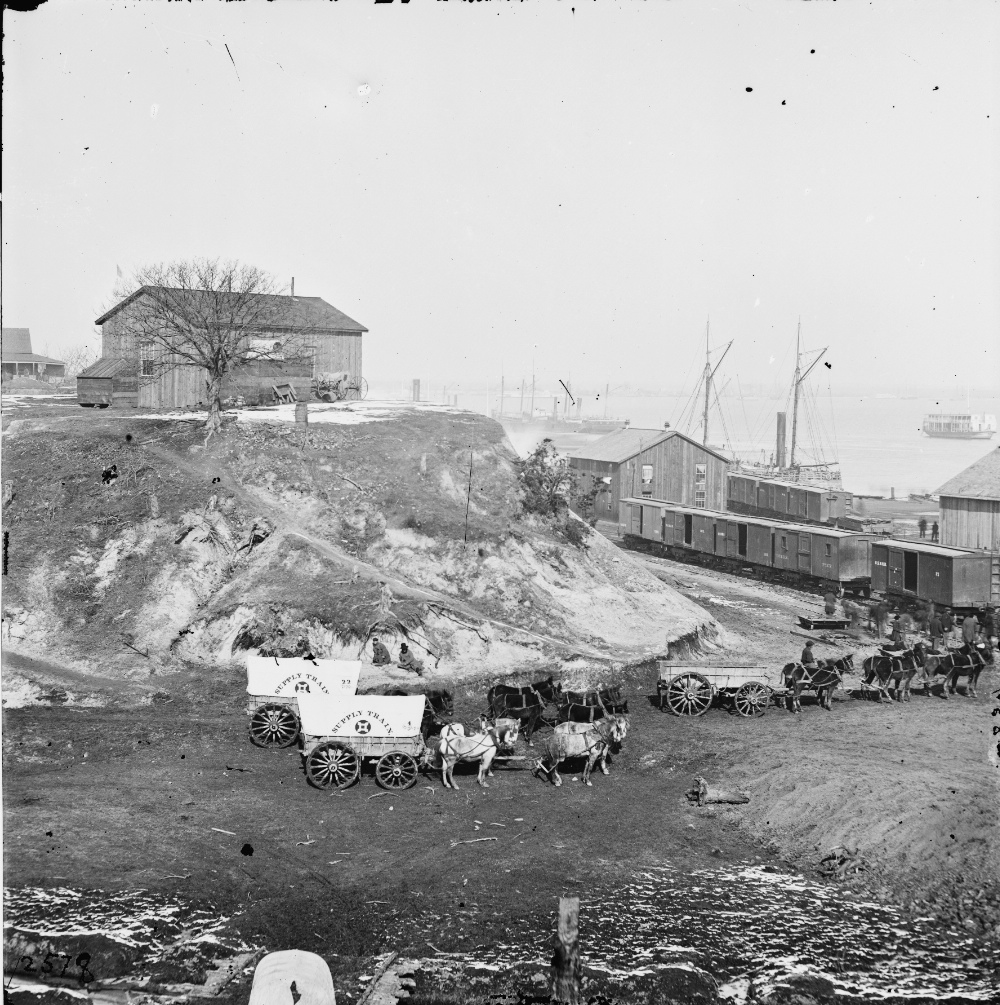A City Point Image Analysis
"Gen. [Marsena R.] Patrick's headquarters and mail wharf" (LC-DIG-cwpb-01973)
Overview
The great detail in the Civil War images available for
download from the Library of Congress and the National Archives is
simply amazing. Combine that detail with the relatively
poor descriptions that are associated with these images and you have a
fantastic opportunity for detailed research. William Frassanito
has been a leader in researching battlefield photos, figuring out
exactly where and when many of iconic battlesfield images were
captured. However there is little detailed information on the
many images taken at City Point. I haven't seen any
information about exactly when these images were produced and little
has been done to understand what exactly is depicted. I have
posted some information that I have discovered about some of the images
on my other City Point pages.
In planning my model railroad, I have picked a date in early December
of 1864 to model. Since there are dozens of City Point images
available, I need to determine the date the image was captured in order
to determine the usefullness of that particular image in recreating the
base in early December, 1864.
While researching the image shown above, in order to determine
it's date, all kinds of interesting discoveries and
questions have arisen. The intentionof this web
page, is to share some of the process that I went through and the
discoveries that I've made.
When was the Picture Taken?
There are several clues that help date this picture.
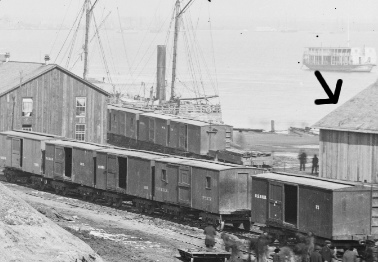
There is a end of year (FY1865) report by D.C. McCallum, Superintendent
of Military Railroad in Virgina in the Official Records. That report
gives an indication when the warehouse that just appears on the edge of
the frame was put up.
"Not much of note in railroad affairs occurred from February 28 to
April 3. The construction department was kept busy making additional
improvements wherever needed, and building a wharf at City Point, in
the gap between the quartermaster's and railroad wharves."
The building at right edge of the picture most likely was put up during March, 1865,
so that would seem to date the picture to the last days of the war.
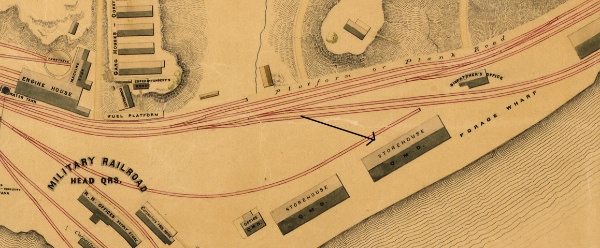
On this crop of Merrick's post war map, I added an arrow to point out this building.
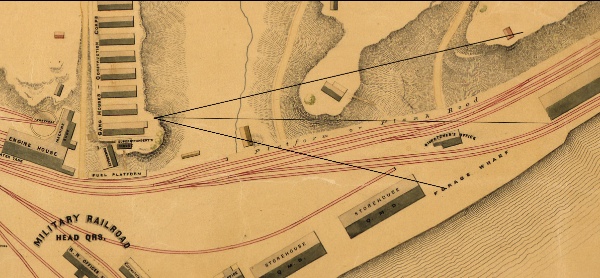
The pictures shown on this web page were all taken from the bluff near
the barracks. A small building on the map, which should be in
view, in front of the wagons, apparently didn't exist at the time of the photograph, and was
built afterward.
There is a companion image taken at the same time, that shows a
complete view of the building that was erected as part of the new wharf. The digitized version can be found
in the National Archives.
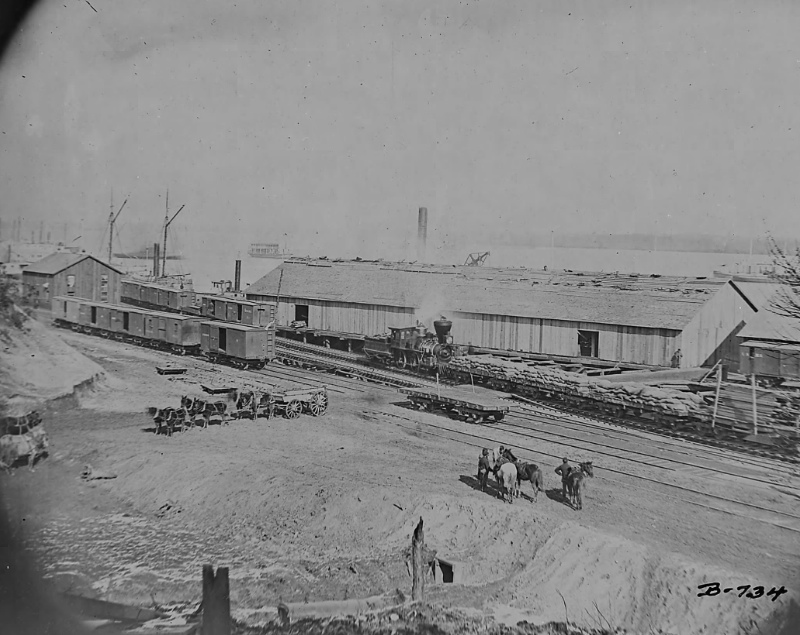
National Archices ARC identifier - 525139
The mules along the left edge of this picture, match up exactly with
the mules in the center of the picture that I'm studying, confirming
that the images were taken within minutes of each other. Also the
string of 5 box cars are positioned in exactly the same way. When
zooming in, it becomes apparent that the roof for this building is
still under construction. If McCallum's report is accurate, then
this would definately place the picture in the approximate March, 1865,
timeframe.
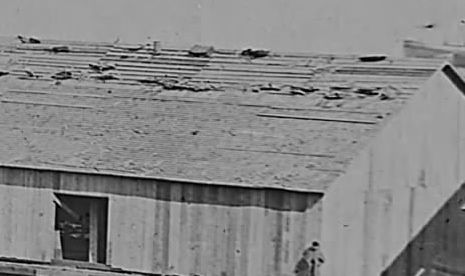
Other details can help date the image. For instance, the amount
of foilage on the trees in this series of pictures is a good clue.
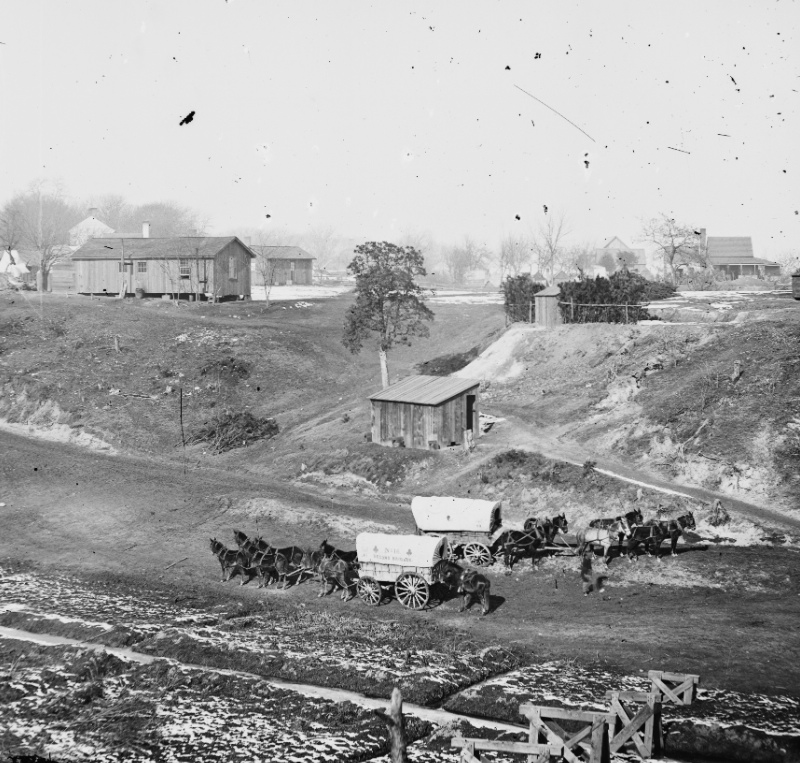
Library of Congress (LC-DIG-cwpb-01970)
Take a look at the foilage. There is quite a bit of foilage among
the different trees, but a number are still bare. I did some
basic research regarding leaf out in Virginia in spring and believe
that this most likely indicates a time frame of late March or early
April.
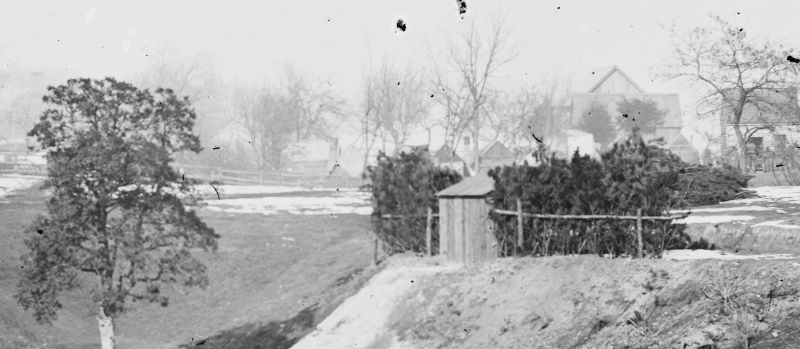
Snow?
In the foreground of the picture and also on the bluff, there appears
to be melting snow on the ground.
If these images were taken in late March, can we corolate the apparent snow on the ground with a known spring snow storm?
I happened to have recently
picked up an interesting book called "Civil War Weather in Virginia",
by Robert K Krick. It contains daily temperature readings done by
a reverend in Georgetown, Maryland, about 90 miles North of City
Point. I hoped I would find an entry for March snow storm, or at
least a stretch of cold weather, from a February snow storm, leading
into March. I pulled the book off the shelf and looked and what I
found was that March was a cool, damp, month, with a lot of rain, but
no snow. Except for a few frosts, the last snow reported came on
Febuary 12th, and there were few warm days and rain showers between
the 12th and the end of Feburary. There were only two days
reported in March that were below freezing and no snow at all and
remember that City Point should be a bit warmer than Georgetown.
I also checked an online copy of a period Richmond, VA newspaper, and
could find no news of snow in March. At this point, I'm fairly
sure of the late March date, but the snow is a bit of puzzle.
Either the snow lasted
from February until the photo was taken, there was an unreported snow
storm, or this is not really snow at
all. I don't know the answer to this puzzle.
Army Wagon Mystery?
The army wagons in these images contain distinctive unit identifiers.
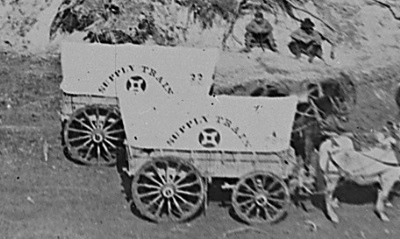
These wagons appear to carry insignia of the 10th corps. I'm
thinking that since the second division's insignia is in white, that
this is the most likely division. The 10th corps was broken
up to form the 24 corps on December 3rd, 1864, well before these
photographs were taken. The second division was
assigned to the actions along the Carolina coast that resulted in the
fall of Fort Fischer. Eventually, the second division became a
component of a reconstitued 10th corps. This new 10th corps was
reconstituted in March, 1865, and was involved in operations in North
Carolina. These wagons were probably leftovers from the original
10th Corps. As the second division was involved in operations
along the coast, the wagons were probably reassigned. They could
have been used by the XXIV corps, where the 1st and 3rd divisions were
assigned or any other unit which continued operating in front of
Petersburg. I think that it is unlikely these wagons at City
Point were involved in operations of the second division in the
Carolinas.
Here is another cropped image that shows another army wagon with a clearly visable insignia.
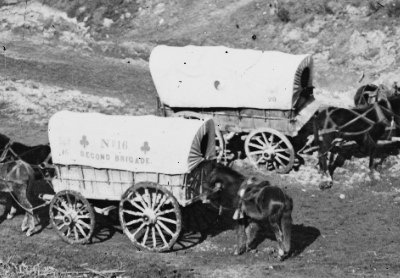
The clover is the second corps insignia. This clover is either
red (1st division) or blue (3rd division). The 2nd division
would be white. Note that the wet plate process is not sensitive
to red light. A red clover should look pretty dark, almost
black. Since this clover is not black, but a medium grey, I
think that the color may be suggesting a blue clover, indicating 3rd
division. Note the soldiers trousers, which should be a light
shade of blue, seen in other portions of this series of images
appear to be about the same shade of grey.
What this mix of wagons was doing at City Point, when the railroad line
would clearly be a more efficient way to supply the troops stationed a
number of miles from City Point, is beyond me.
Railroad Work Crew
As I was studying this photo for clues about when it was made, I
realized that it captured a railroad work crew at work. By the
time the photographer makes the next image, these guys have moved on to
their next task and have disappeared from view.
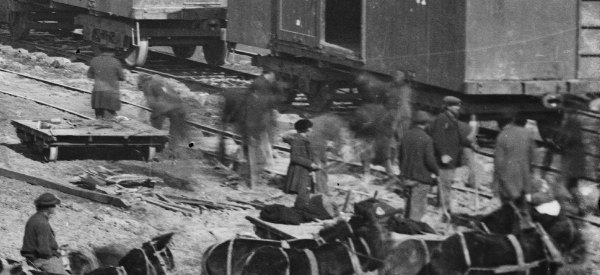
Locomotive in Action
This series of photos also captures a locomotive in action.
In the first image, you can see smoke rising from an engine that is
located just out fof view, behind the bluff.
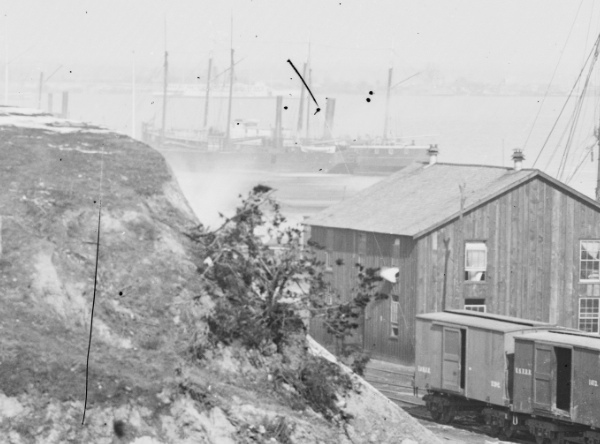
In one of the follow on photos, you can see the work crew has moved on,
and a locomotive is pushing or pulling a string of loaded flat
cars. I'd like to think that the locomotive was waiting for the
work crew to repair the track (1st image), before moving on with it's
job (2nd image).
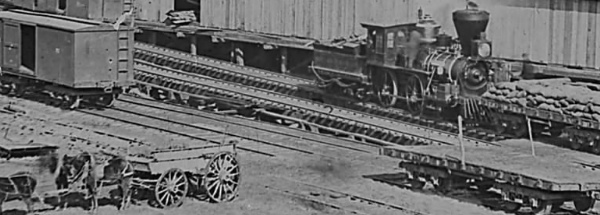
So much more could be investigated about the details in these images, but I'll stop here, for now.
Part 2 of Analysis
After posting the initial analysis, I discovered some more information, which changes my initial conclusions, a bit.
First I discovered that another picture was part of this series.
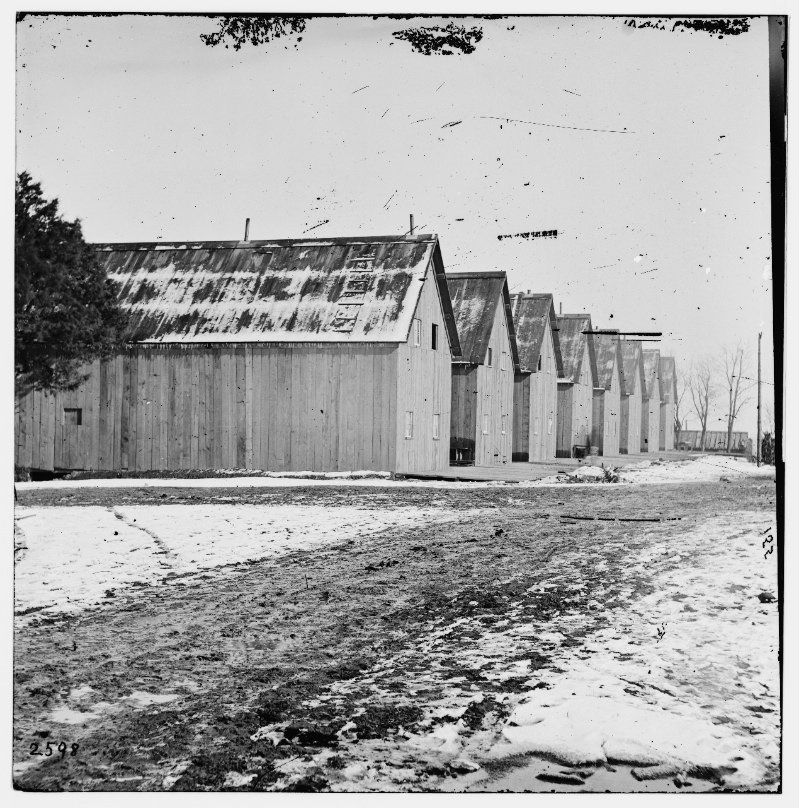
In this image, the photographer turned around and took pictures of the
barracks, that were behind him, in the previous images. It
clearly shows icicles hanging from the eaves. With this evidence,
there can be no doubt that these images are of snow.
Icicles form on days when the temperature is a bit below
freezing. The roof of a heated building may raise above
freezing as the relatively warm air inside the building heats it.
Then the snow on the roof will melt, run down the roof and then
freeze again when the melted snow reaches the eaves which are not
heated by the warm air inside the building. Since there is snow
on the roofs of the buildings in this image, it is likely to be
fairly fresh snow. The heat inside a building like these
quickly constructed barracks, would melt any snow on the roof in a
climate like Virginia in fairly short amount of time.
I suspect that this picture was taken within a few days after the
snowfall.

The other information, is something I knew all along, but never
connected to these photographs. That is that some deciduous tress
loose their leaves in the spring. In a black and white photo like
this, it would be hard to tell if the leaves were brown or green.
I might do a color analysis at some point, do not have time, right
now. A possible candidate for the tree at the left of this image
is the Pin Oak, which is well known for sheading it's leaves in
springtime, just before leaf out.
I can not find any likely evidence of snowfall in March, so I'm
starting to believe that the pictures were taken soon after one of the
Feburary snow storms reported in the book, "Civil War Weather in
Virginia". It is possible that the building under construction,
was built before the wharf, described in McCallum's report, or that
there is an error in the report.
Back
to Mike's
Hobby Home Page
